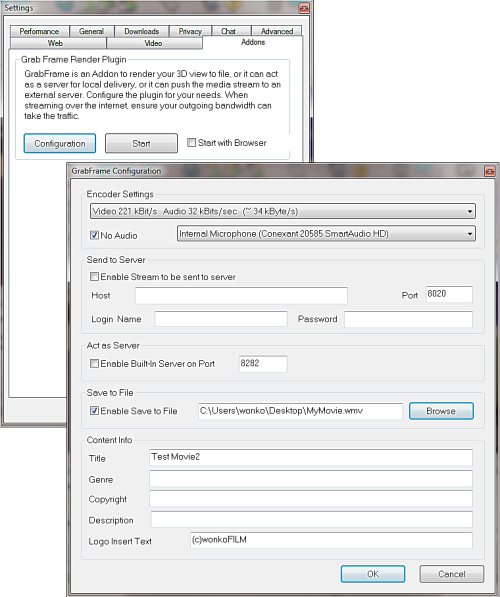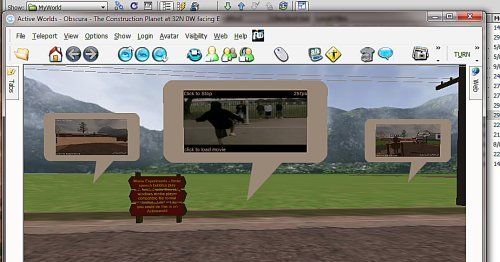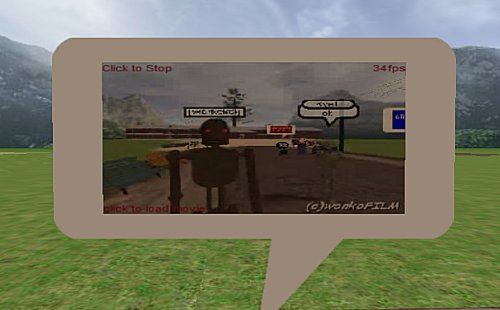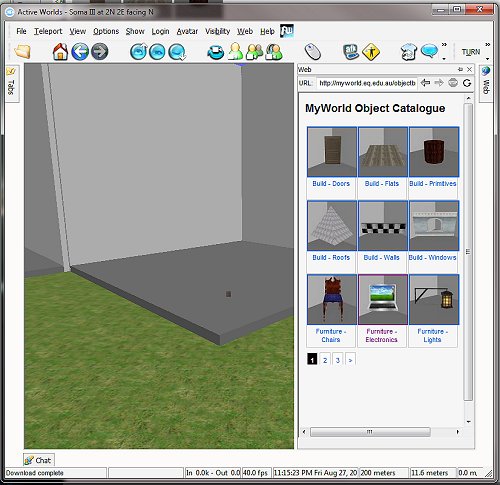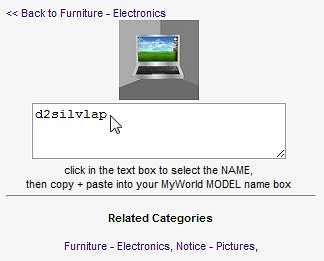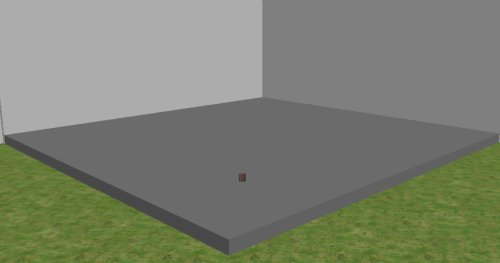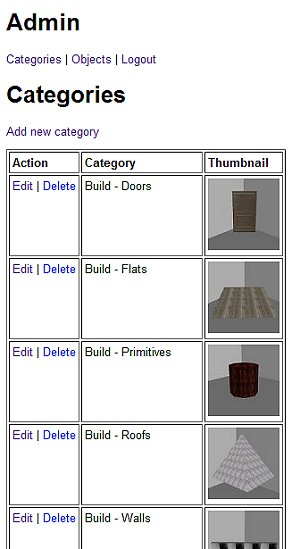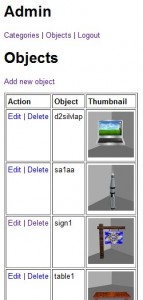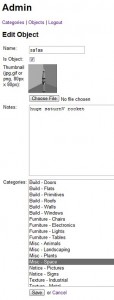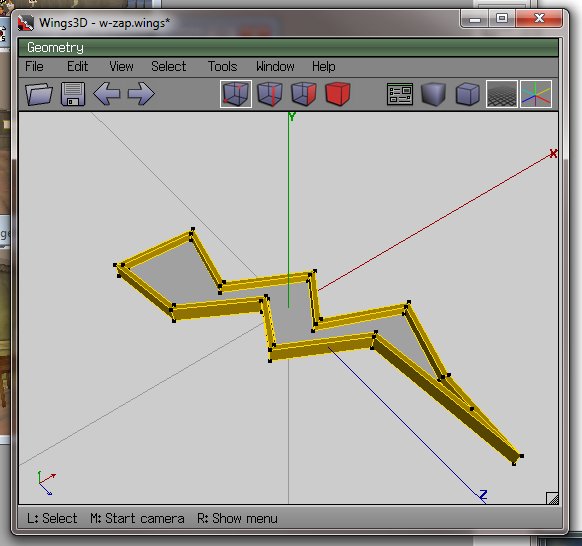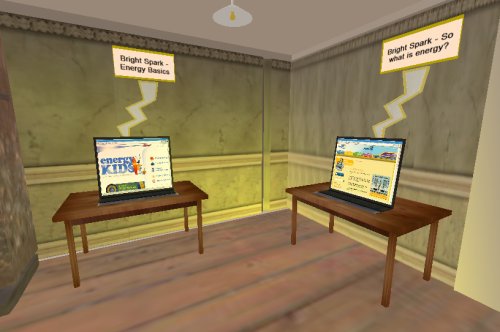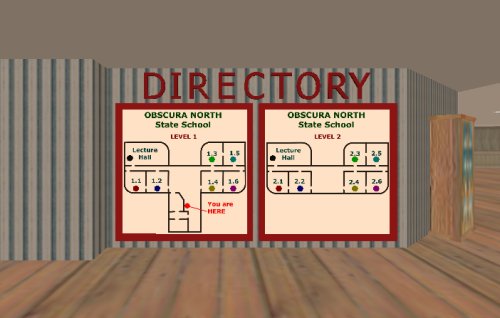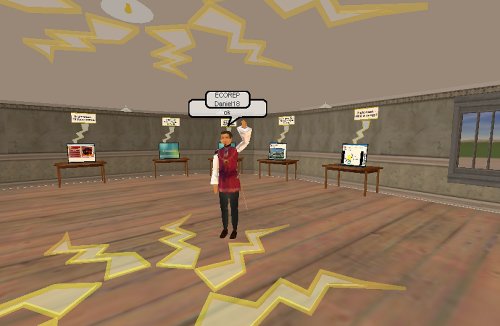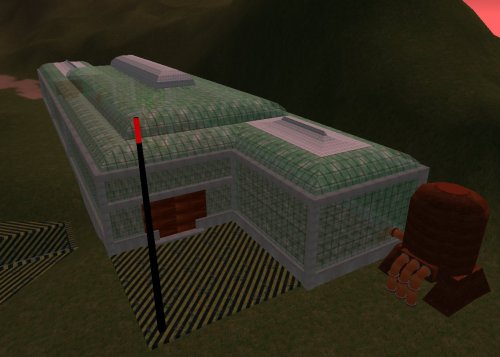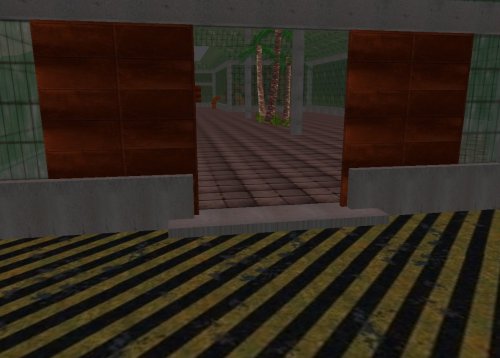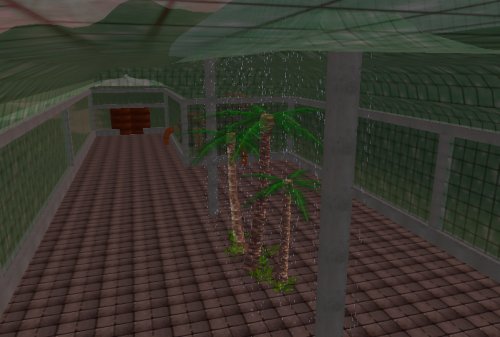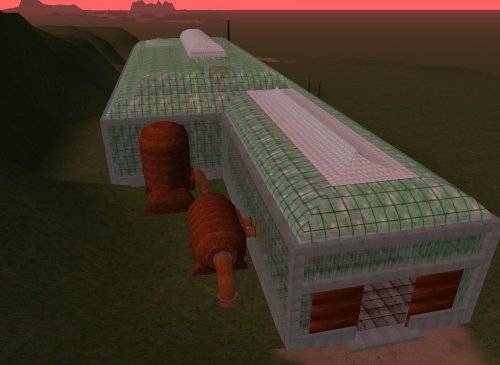Machinimatic …
…now the 3D world can be a very powerful and constructionist (and constructivist) place to get creative people working in, but generally “what happens in-world, stays in-world” … until now.
While digging around in the Activeworlds client (the program that provides you with access to the world) settings, I came across an “Addin” that is a scene grabber.
…you can use it to capture world action in WMV movie format, with sound, at varying sample/frame rates, with some control over the frame size. It got me thinking as to what we could do with that facility.
Now I have not done much “machinima” (or more correctly, not done very much in the way of digital video at all really, yes I know I must be a philistine). From my readings on Machinema, it is essentially movie making using game engines, but it seems to me that we could easily do that here.
As the worlds we are building are constructionist, we could get kids to make sets, lights, our avatars could wear costumes as actors who could act out a story whilst someone else could film it. Nice.
Up until now I had assumed it was not possible to use this movie footage in-world. Laaaaate saturday night I stumbled across a poorly documented feature of SIGN objects (yes, those things that traditionally display TEXT messages) as opposed to PICTURE objects (which are designed to display graphics … go figure).
You can spawn a MOVIE PLAYER (well, in truth it is an embedded Windows Media Player window on a SIGN object, and stream your movie on it, in world, on demand.
Now to me this is pretty exciting, so I set about testing it. I had some speech-bubble signs, placed them opposite a line of seats (a drive in movie of sorts, well, “fly in” more accurately) and had a play with some WMVs sourced from Google – they worked a treat.
…sure there is some delay with downloading, as the player buffers enough to play, but we get movies, with sound, in-world. Excitingly, you can have multiple streams independently playing for each person, there is “3D sound” which is directional – it emanates from the sign in much the same way that a sound or noise does, there is some control over captioning and start/stop, loop etc.
So I recorded a walk around, uploaded the resultant WMV file, embedded it using the code
create sign; activate media url=http://myworld.eq.edu.au/media/WonkoTestMovie1.wmv “click to load movie”
and it worked a treat. In the morning, i got a test pleb (thanks Kye1) to check they too could see the movie (thinking it might just be some wierd admin trick – there are a few of those) and he was also able to see the movie – interestingly it is not streamed synchronously to all users – while he was watching, I had no clue he was, except his avatar was stationary for a while.
So, after asking him for permission, we staged a 2 person, one bot (will introduce you to my pet bot in another posting) movie, filmed it and posted it as well:
Kye1 was beside himself (literally) when the movie loaded in-world with him – I can see wonderful potential with this … you know what would be perfect – if the new iShare service the learning Place are about to launch lets the kids upload their movies in a way that can be seen by an in-world player – I can imagine it now – film nights where people BYO a film, virtual film studios, film clubs …
…what do you think?
iObject v1.0b
…so, in a previous post I ranted about the need for an in-world Object Catalog, as opposed to an object yard.
In-world, the object catalog manifests itself (thanks to some nifty PHP development by Malcolm) in the integrated browser:
Cybernaut builders browse the categories of objects, textures and so on available to them in the MyWorld object path, then…
…then pick a category that suits the sort of object they are looking for, then
…browse the paginated list of objects, via their thumbnails, then then click on the object to get a copy-pasteable link to the object name which they then use to customize the objects they have just cloned. I like that when you click on the name, it is highlighted – then via copy-paste you have the thing you need to make one, the model name. This will also work with textures, of which we also have a HUGE collection.
It is all controlled by some back-end database work, we control the categories, thumbnails and so on, which is all very hoopy.
This version is functional and awaits instantiation with the actual object collection, which necessitates the ADMIN section to upload, add, edit and manipulate the collection into something workable.
The next stage is to get lovely, patient people to systematically pop objects in a lightbox and screenshot them:
…so I made a cluster of oversize (as some objects are huge) photo booths on a yet-to-be developed world, popped a blank primitive on the ground plane as a seeding object, then began concocting instructions for our intrepid catalogers.
We have a category hierarchy which I have begin to populate – building objects, furniture, accessories etc, and within these, sub categories:
By prefixing the name, we group them in the resultant catalog screen (which is a paginated, alphabetic sort), and no, I am not sure I have got them all yet – the available object collection is VAST and I have no doubt that new, functional category names are staring me in the face but for the life of me I cannot see them, yet.
Managing objects via Delete/Edit and Add all seem to work nicely according to spec (I wanted a compact catalog that would fit as a sidebar to the world screen, hence it’s compact appearance and slick nav.
Having done a few add/edits (and discovering application/permission glitches subsequently fixed) and doing some cosmetic changed to layout and captioning, I think we have a functional system that is ready to rock and roll.
I like that an object can be in more than one category – the silver laptop to the left, for instance is a bit of electronics gear as well as a picture object (you can place a nominated web-hosted image in it’s screen).
Some objects can be used for multiple jobs – flats can be floors, ceilings, ground covers etc or if you tip them on their sides, they become walls (remember I built 99% of the science bunker out of a “wall1” object – using it as walls, floors, ceilings, steps, balustrade and so on by rotating, scaling, texturing and masking).
Will this work? I am not sure – I think so, it is so much more convenient that trolling through an object yard and the best thing is the URL for the catalog works out of world, so you can realistically plan a build without being in world. Great for cybernauts who want to work effectively – planning the build is much of the work.
What is left? Well, (after I get current object path directory listings) the hard slog of filling it up is the next priority … DebJ, I hope you have some patient volunteers to help in that regard because I am buggered if I want to do that by myself.
There are some niceties I would like for iObject2.0 – mostly web twoey things, probably a larger view of the object (80x80px as the only preview of an object is a little small), surfacing of the “notes” section might also be nice to value add to what is known about an object as some have oddities or companion files, along with collapsible folders, general branding and some automatic re-scaling of uploaded images, but they are for another budget I suppose – am more than happy with the start we have.
There be TROLLS…
…now a TROLL is someone who comes in determined to cause mayhem, disarray and pain to other members of a forum, community or world. The motivations behind “trolls” are, I am sure, many and varied. I do not do child-psychology, so can only guess based on observation.
Troll behavior in a virtual world takes on many forms. At the risk of compiling an “how to” guide I will attempt to describe some of the observed troll-like behaviors I have witnessed.
In an activeworld users have build rights, some trolls make dozens of copies of objects to obliterate existing things, block off exits, make massive “notice me” constructions in deliberately inconvenient places, leave signs with inappropriate messages, send copious mischievous telegrams, block chat channels, fly constantly in the face of other users and so so.
What trolls do not realise (or perhaps they do?) is that their actions are usually logged – anything they create is badged with their username (citizen number actually, so if they decide to change their name, the object still is owned by them). What I am increasingly aware of is that trolls do not really care if you know THEY did things, all too often rushing to the “I didn’t do anything” or “other people were doing it so I thought I would join in” excuse, but rarely an apology or recognition that they in any way compromised the community they disrupted.
…so what do you do? No, seriously, what do you do if you want to stamp out troll-like behaviour?
If someone is determined to be a troll, they can be one in so many ways – the interweb is an empowering place for determined trolls. Noticing and correcting their actions all too often “feeds” the behaviour, attempting to remediate it only exacerbates it, or gets other semi-trolls to come out of their shells and go full-troll.
So what is the solution? How do we do TROLL MANAGEMENT?
…is there anyone out there? I would love to know what you think.
I would hate to think a project on a scale such as MyWorld was destroyed by trolls, but nightly I am in, cleaning up junk and putting out fires – kids UNSUPERVISED running riot, claiming innocence, not thinking they are accountable. It is very frustrating indeed, maybe I am taking it personally but it is really hard to see something you have spent a lot of time in, being broken maliciously. I would love to think we have the support of the supervising teachers, but how does that evidence itself?
Do we need a world charter, an acceptable use policy? How do we police it? Do we even need to consider such a thing?
…discuss, please.
Bright Spark…
…now the cybernauts are investigating energy at the moment, or more importantly what it is and why that is important. It bridges to types of energy and sustainability and so on. My lagged brain came up with the notion of a “bright spark” as energy-related, so fired up trusty old Wings3D to make one.
I then edited the RWX file exported and changed the RGB lighting, and added a little less OPACITY, meaning by changing a number from 100 to 70, the object rezzes in-world partially transparent, which is sort of cool.
Information stations were then established containing links to websites, learning objects etc:
…and a little mood lighting above and it seems to work. I used classrooms 1.1 and 1.2, ground floor.
I have another 4 classrooms on this level to do the investigation into renewable and non-renewable energy. I think the location is ideal – adjacent to the eco-theatre, downstairs from discussion rooms and so on – all in all this building seems to be working out rather nicely.
So with a little decoration (can you see how the zappy things are a little bit see-through? This is the opacity of the model and I am guessing this is much less resource intensive as a way of gaining transparency than masking, which requires an initial surface and another surface modifying it) and the “Bright Spark” gallery is largely ready to go. Tried to add some “contribute your ideas” activities to the “click on stuff to find out about it” else I suspect this activity would have been better done as a web page.
…which brings up an interesting question – does being in the “world” add to the activity, or would a website be just as effective at engaging and immersing? Does this level of immersion matter at the ages our cybernauts are in, or does it provide a new level of distraction for kids who cannot multi-task at the best of times, or even single task at the worst of times?
How green is my …
…so we are going to embed resources and activities about atmospheric science, and green house gas emissions, naturally I thought the most logical place to do this was inside a greenhouse.
I had a plateau set aside for this building, nestled nicely in the southern ranges on SciPrime. Rather than just build a rectangular thing, I decided on a few protuberances and sexy roof line, and I used a primitive texture (the default build texture as it happens is sort of greeny griddy stuff) with some transparency masking to give the illusion of reinforced glass panels (well, it looks like that to me at least).
I remembered a scripting trick that let me do nice rusting (the sciprime predominant theme is rust, just in case you are wondering) sliding doors – you click one, they both open because you tell each of them about each other. After lab-rat testing with some in-world cybernauts, it appears they need to stay open for about 10 seconds before automatically shutting – that seems to work as a reasonable time to get through for even noobs.
I found the sound that was used for the original star trek door opening (a sic-fi woosh) and that is the sound made as the doors slide open (well, I thought it was cute at least).
I have not yet kitted out the interior as I am still awaiting the content from our science curriculum expert, but thought some irrigation/humidity would be a nice touch, so found some “rain” that moves, and a few cycads and ferns to give a primordial tropical feel – have yet to add garden beds, organic matter etc. but we will subdivide this space into a few project/display rooms.
You _may_ be able to see the tanks and pipes – completest me has devised a water and nutrient recyc system, tank farm and engine plant – I do not think the extra effort is wasted, I aim for reasonable (or at least partly believable architecture)
So we now have an upper terrace occupied by the atmospheric research centre, the terrace below will house the “Collaboratory”, the terrace below that will house the soon-to-be-relocated non-eco school. Underground this mountain range here is the science bunker, so we are beginning to get a science-themed compound. Quite happy with the progress – amazing what can be done in the wee hours of the night.
